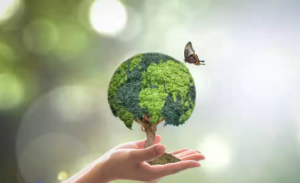
Management of Natural Resources : A Synopsis
Introductions
The inclusion of technology into many spheres in the modern era has transformed our attitude to conventional methods. Natural resource management is one of the most important sectors gaining from technical developments. Using technology becomes crucial for sustainable development as we confront mounting environmental problems and the increasing pressure on natural resources. This paper investigates how modern technologies are changing resource management going forward, looks at innovative ideas, and considers the critical part technology plays in controlling natural resources.
Knowledge of Natural Resource Management
Define natural resource management.
Natural resource management (NRM) is the methodical practice of controlling the use and preservation of natural resources including ecosystems, land, water, and minerals. Ensuring sustainable use of these resources will help to minimize environmental effect while nevertheless meeting present and future needs.

Value of Sustainable Resource Management
Several causes depend on effective NRM:
Sustainability guarantees that resources will last for next generations.
Appropriate management helps stop loss of biodiversity and deterioration of the environment.
Use of sustainable resources helps to promote livelihoods and economic growth.
Social Equity: It advances equitable distribution of resources for every society.
Natural Resource Management Technological Innovations
Geographic Information Systems, or GIS.
What is GIS?
Geographic Information Systems (GIS) are technical instruments for storing, analyzing, visualizing spatial data. Their thorough knowledge of the spatial distribution of resources helps to significantly guide natural resource management.
GIS mapping and monitoring enable accurate maps of natural resources as well as ongoing monitoring of changes across time.
Analyzing spatial patterns helps one maximize the distribution of resources.
GIS is applied in risk assessment and natural disaster planning for events including floods and wildfires.
Remote Sensation
Remote Sensing Introduction
Remote sensing is the gathering of surface data about the Earth via satellite or aircraft photography without direct interaction. Our management of natural resources has been transformed by this technology.

advantages of remote sensing
Large-scale observing is : Remote sensing helps to monitor vast and unreachable regions.
It offers information on environmental damage, land cover changes, and deforestation.
Farmers apply remote sensing in order to maximize crop management and lower environmental impact.
Resource Management: Drones
The emergence of drones
Because they can gather high-resolution photographs and data from above, drones—also known as unmanned aerial vehicles UAVs have grown rather popular in natural resource management.
Drone Utilases
Drones are employed in forest management to track illegal logging, evaluate forest condition, and do animal studies.
Water resources support watershed condition assessment, pollution detection, and mapping and monitoring of water bodies.
During natural events, drones offer real-time data that helps with damage assessment and relief operations.
Computer learning and artificial intelligence
Machine Learning and Artificial Intelligence Overview
Artificial intelligence (AI) and machine learning (ML) employ computational models and algorithms to examine vast databases and provide predictions. By offering pragmatic insights from challenging data, these tools improve natural resource management.
Uses for ML and AI
Predictive analytics AI models predict possible environmental effects, resource availability, and climatic patterns.
Machine learning techniques maximize methods of resource allocation and management.
AI systems support decision-making by means of data trend analysis and recommendations.
IoT, or Internet of Things:
IoT Idea
The Internet of Things (IoT) is the network of linked data collecting and exchanging connected devices. IoT devices offer real-time data on several environmental indicators in natural resource management.
IoT Uses
IoT sensors in smart agriculture track crop health, soil moisture, and temperature, therefore allowing precision farming.
IoT sensors of water use, quality, and distribution help to better manage resources.
IoT-enabled tags track animal motions and activities, therefore supporting conservation initiatives.
Technology in Natural Resource Management Case Studies
First case study: Brazil’s forest preservation
Remote sensing technologies and improved GIS have been crucial in Brazil in helping to stop Amazon Rainforest destruction. Analyzing satellite images helps authorities identify illicit logging operations and more successfully enforce conservation policies.
Second Case Study : Precision Agriculture American Style
Precision agriculture employs IoT sensors and drones in the United States to maximize agricultural output. By accurately applying fertilizers, changing irrigation, and tracking soil health, farmers improve yields and lower environmental impact.
Case Study Three : Australian Water Management
Australia’s catastrophic droughs have pushed IoT and artificial intelligence technology in water management to front stage. Predictive models and smart sensors enable effective water resource management, therefore guaranteeing sustainable use in urban and agricultural sectors.
Difficulties and Future Routines
Technological Obstacles
Notwithstanding the advantages, numerous difficulties prevent the general use of technology in the management of natural resources:
Advanced technologies can be costly, especially for underdeveloped areas.
Managing and safeguarding private information gathered via different technologies is absolutely vital.
Technical Expertise : Good application of technology calls for trained staff members.
Future Pathways
Future integration of emerging technologies, such blockchain for transparent resource monitoring and augmented reality for improved visualization, is probably going to be more evident.
Data-sharing projects and cooperative platforms will help to improve resource management over boundaries and industries.
Sustainable management depends on the development of laws and rules supporting the moral use of technology and handling related issues.
Finally
Unquestionably, technology has changed how we manage natural resources and provides creative answers for some of the most urgent environmental problems. Improving our management and preservation of natural resources has been much aided by Geographic Information Systems (GIS), remote sensing, drones, artificial intelligence (AI), and the Internet of Things (IoT).
Although obstacles still exist, technology has great power to propel environmental growth and enhance resource management. Embracing these technical developments and tackling related issues will be essential going forward to guarantee a sustainable and balanced method of managing natural resources.
Using technology’s power will help us to make wise decisions, maximize resource utilization, and preserve our earth for next generations. Though the path towards efficient natural resource management is long-standing, with constant innovation and teamwork we can create a sustainable future.